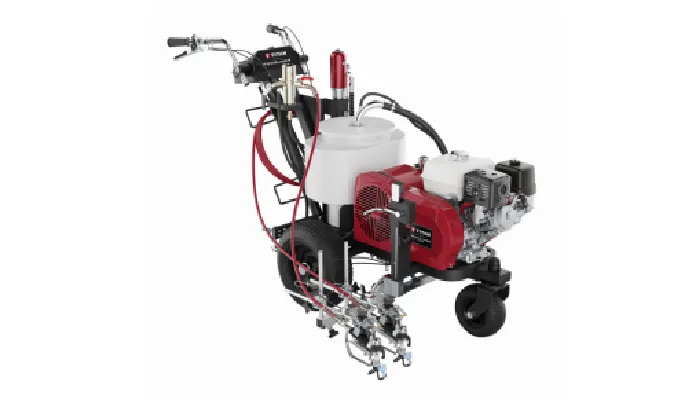
How to Choose a Line Painting Machine for Your Project
Choosing a line painting machine can feel a bit overwhelming, but focusing on key factors simplifies the process. First, consider the type of job you’re tackling; manual machines work well for small areas while ride-on options are better for larger spaces. Evaluate important features too, like paint capacity and line width adjustment, these affect efficiency and versatility. Think about the surface you’ll be working with since different materials require specific machines. Cost matters as well; investing in a higher-quality model might save you time in the long run. Ultimately, choosing wisely helps achieve neat lines and makes your project easier!
1. Types of Line Painting Machines
When selecting a line painting machines, it’s important to understand the different types available. Manual striping machines are lightweight and perfect for small jobs or detailed work, giving the operator precise control. For larger areas, self-propelled striping machines can save effort, as they feature a powered drive that makes them more efficient and easier to handle.
Ride-on striping machines take comfort to the next level, allowing operators to sit while they work, making them suitable for extended hours on big projects. If you need a machine that delivers a smooth finish, airless striping machines are a great choice as they provide better paint adhesion without using air, which can lead to more durable results.
Walk-behind striping machines are versatile and can adapt to various job sizes, offering a good balance between control and efficiency. When considering power sources, electric machines are quieter and require less maintenance, while gas-powered models often deliver more mobility and power, especially when working in remote areas.
For specialized applications, field and road marking machines are designed specifically for tasks like road markings or athletic fields. Compact models work well in tight spaces, ensuring easy handling and storage. High-pressure machines are capable of handling thicker paints, making them ideal for demanding applications. Lastly, portable models are lightweight, making them easy to transport between different job sites, which is a huge benefit for contractors.
2. Key Features to Evaluate
When selecting a line painting machine, focusing on key features can significantly impact your project’s outcome. Adjustable speed settings allow operators to fine-tune the application speed, which is crucial for achieving the desired line thickness and quality. Machines equipped with built-in paint mixers help in maintaining a consistent paint mixture, leading to smoother application results. Durable wheels are essential for maneuverability and stability, especially when working on uneven surfaces. Additionally, having pressure control is vital for achieving different line qualities, enabling you to customize the finish as needed.
Consider the convenience of storage compartments; integrated storage for tools and accessories can keep your workspace organized and efficient. Clear user manuals and reliable customer support are assets that can ease the operation and maintenance of the machine. Warranty options can provide peace of mind regarding the machine’s durability and reliability, making it a crucial factor in your decision. The weight and size of the machine should also be taken into account, as they influence transport and usability across various environments. Lastly, safety features, such as automatic shut-off and safety guards, are critical for protecting operators during use, ensuring a safer working experience. Compatibility with accessories is another important aspect; ensure the machine can accommodate various attachments to expand its functionality and adaptability for different tasks.
3. Project-Specific Considerations
Environmental conditions play a significant role in line painting. If your project is outdoors, consider how weather and temperature might affect the paint application and drying times. For instance, painting in humid conditions might require a machine that can handle slower drying paints. Additionally, local regulations can dictate the type of markings you need, which may influence your choice of paint and machine. So, be sure to familiarize yourself with any specific requirements in your area.
Another essential factor is your project timeline. If you need to complete the work quickly, choose a machine known for its speed and efficiency to help meet those tight deadlines. Surface conditions should also be assessed; rough or uneven surfaces may require a different machine compared to smooth asphalt. Similarly, consider the accessibility of the worksite. In urban areas with limited space, compact machines may be necessary to maneuver effectively.
The type of markings you plan to create is also crucial. Different jobs may require solid lines, dashed lines, or arrows, which can all affect your machine selection. If you are working in high-traffic areas, think about how often re-striping will be needed. Machines that can handle frequent applications without sacrificing quality can be a worthwhile investment. Additionally, ensure that the machine you choose is compatible with the type of paint you plan to use, whether it’s water-based, solvent-based, or eco-friendly. Lastly, budget constraints will guide your decision; balancing quality with cost is key, especially in larger projects. Finally, keep in mind the size of your crew, as this can dictate the type of machine that will best suit your operation.
4. Cost Considerations
When selecting a line painting machine, cost is a significant factor that extends beyond the initial purchase price. First, assess the upfront cost of the machine. Higher-priced models typically offer enhanced features and durability, which can be beneficial if you plan to use the machine frequently. However, ensure that these features align with your budget and project needs.
Next, consider long-term maintenance costs. Ongoing expenses for repairs, parts replacement, and general upkeep can add up over time. Investing in a machine with solid warranty coverage can help mitigate these expenses, as it may cover specific repairs during the warranty period.
Fuel and energy costs should also be factored into your decision. Gas-powered machines may incur higher fuel costs, while electric models can lead to increased electricity bills. Evaluate which operational costs fit within your project’s budget.
Additionally, explore the potential resale value of the machine. Some models retain their value better than others, so it may be worthwhile to research resale prices for future considerations. If the initial investment is a concern, look for financing options or leasing plans that can ease the upfront financial burden.
For those purchasing multiple machines, inquire about bulk purchasing agreements, as these often come with discounts that can lead to significant savings. Don’t forget to factor in training costs for operators. If specialized training is required to effectively use the machine, this can add to your overall project costs.
Lastly, ensure that replacement parts are readily available and affordable. This can minimize downtime and repair costs, keeping your project on schedule.
5. Accessories and Enhancements
When selecting a line painting machine, consider the various accessories and enhancements that can elevate your project. Guided line systems, for instance, can help you achieve straight lines with minimal effort, allowing you to focus on other aspects of the job. Custom color options are also worth exploring; some machines let you mix specific paint colors to meet your project’s requirements, ensuring that you get the exact shade you need.
Paint stripping tools are essential for removing old markings before applying new ones, which can significantly improve efficiency. Additionally, variable width spray nozzles offer flexibility in line widths, making it easy to adapt to different applications, whether you are marking parking spaces or directional arrows.
Maintenance is key to optimal performance, so consider machines that come with cleaning kits to prevent clogging. Storage bags are useful for organizing and transporting your tools and accessories, while protective covers can extend the machine’s lifespan by shielding it from harsh weather when not in use. Dust shields are another handy accessory, keeping debris away from the marking area for cleaner lines.
Lastly, if your project requires increased visibility, look for reflective tape applicators that help apply reflective tape alongside paint, enhancing safety in low-light conditions. Upgraded paint tanks can also be beneficial, as larger or specialized tanks reduce downtime during extensive projects, allowing for smoother workflow.
- Guided Line Systems: These help ensure straight lines without the need for constant attention from the operator.
- Custom Color Options: Some machines allow for custom paint mixes or colors to meet specific project needs.
- Paint Stripping Tools: Accessories that can help remove old paint or markings before reapplication can enhance job efficiency.
- Variable Width Spray Nozzles: These provide additional flexibility in line widths for different applications.
- Cleaning Kits: Essential for maintaining the machine, preventing clogging and ensuring optimal performance.
- Storage Bags: These can help organize and transport accessories, tools, and supplies effectively.
- Protective Covers: Covers for machines can help extend their longevity by protecting them from the elements when not in use.
- Dust Shields: These keep debris away from the marking area, resulting in cleaner lines.
- Reflective Tape Applicators: Accessories that help apply reflective tape alongside paint for improved visibility.
- Upgraded Paint Tanks: Larger or specialized tanks can improve efficiency and reduce downtime during larger projects.
Frequently Asked Questions
What should I consider when picking a line painting machine for my job?
You should think about the size of your project, the type of surface you’ll be painting, and the kind of paint you’ll use. Also, consider how often you plan to use the machine, as that can affect your choice.
Are there different types of line painting machines for different projects?
Yes, there are several types, including walk-behind, ride-on, and hand-held machines. Each type is suited for different scopes of work, so choose one that matches your project’s needs.
How do I know what paint to use with my line painting machine?
Check the manufacturer’s guidelines for the machine, as they often recommend specific types of paint. Generally, you’ll want to use paint that is suitable for the surface you’re working on and compatible with the machine.
Can I use a single line painting machine for various projects?
Yes, many machines are versatile and can handle different types of projects, from parking lots to sports fields. Just ensure you clean and adjust the machine appropriately between jobs.
What features should I look for in a quality line painting machine?
Look for features like adjustable line width, easy maneuverability, durability, and user-friendly controls. These aspects can make your job easier and help achieve better results.
TL;DR Choosing the right line painting machine is essential for project success. Consider different types like manual, self-propelled, and ride-on machines based on the area size and surface type. Evaluate key features such as paint capacity and ease of use, and think about project specifics including surface compatibility and frequency of use. Budget accordingly as prices vary widely, and look into accessories for enhanced functionality, like laser guides and reflective bead dispensers to improve visibility and accuracy.



